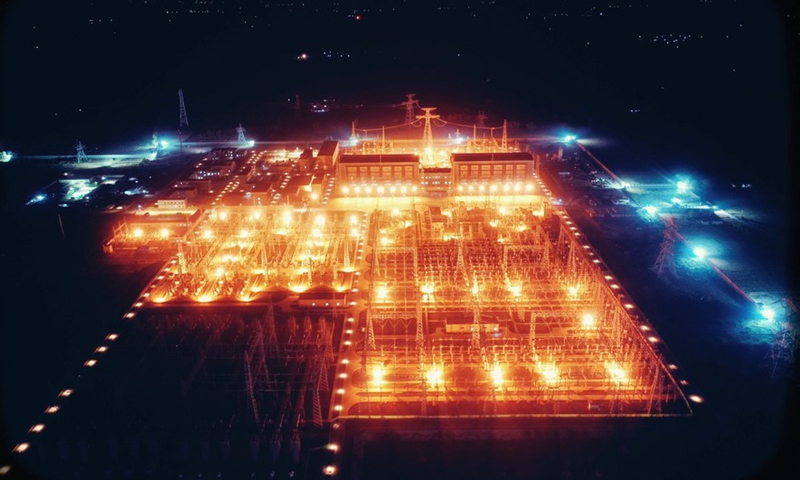
Photo taken on April 10, 2021 shows a night view of the Lahore converter station of the ±660kV Matiari-Lahore high-voltage direct current (HVDC) transmission project under the China-Pakistan Economic Corridor (CPEC) in Pakistan's eastern Punjab Province.Photo:Xinhua
China has earned respect and admiration around the world for the progress it has made over the last four decades. The reforms of opening-up, started by Deng Xiaoping in the year 1978, put China on the development path. Since then, China's per capita income has multiplied many times; rising from just $156 to $10,434 in 2020 and lifting 800 million people out of poverty. Economic transformation at this scale and speed surely has no precedence in human history and the Chinese people and the leadership of the Communist Party of China deserve credit for this.
Many factors contributed to this transformation, with Special Economic Zones (SEZs) playing an important role. Although not a novel concept, the Chinese approached it in a novel way, and this is where the innovation lies.
Economic zones in China began as an oasis of the market economy in the midst of a vast sea of the planned economy, with a focus on path exploration and scientific development.
In this context, SEZs played a unique role in the economic transformation by allowing China to open up gradually to the outside world while attracting FDI compatible with the size and performance of the economy. The industrial structure of SEZs was subject to change in response to market signals, thus making them viable and sustainable over time. As a result, its broader role has evolved from path exploration to scientific development to innovation.
China's development path that goes through Special Economic Zones contains numerous lessons for other developing countries like Pakistan. For this very reason, policymakers in Pakistan have correctly identified its importance and intend to apply the same concept, albeit not for all of the reasons that the Chinese did, such as path exploration, but for many others including scientific development, integration in the global values chains via Chinese value chains, exports promotion and many other benefits attributed to any modern-day SEZ in the developing world.
To this end, the Special Economic Zone Act 2012 (amended 2016) in Pakistan provides the appropriate policy framework, borrowing many of the concepts from China to steer Pakistan on the industrialization journey and, eventually, put the country on the path to modernization and scientific development, socio-economic development, and above all, create well-being and prosperity.
The SEZ Act has been expanded with an incentive package that includes a 10-year exemption from all taxes on income accruable in connection with the development and operation of the SEZ for 10 years. The same incentive is also extended to the zone enterprises. Additionally, the Package includes a one-time tariff exemption on capital goods imports for both developer and zone enterprises. A revised and more generous incentive package is also under consideration in the Federal Board of Investment. Province-specific incentives supplement the existing package.
To emphasize the government's commitment toward investors' facilitation to promote industrialization, the Act has been placed under the control and management of the Board of Investment (BoI) in the Prime Minister's Office.
The Board of Approval (BoA) in the BoI, chaired by the prime minister, has so far approved 22 Special Economic Zones including four SEZs under China Pakistan Economic Corridor (CPEC), namely Allama Iqbal Industrial City in Faisalabad (AIIC), Dhabeji SEZ in Karachi, Bostan in Quetta and Rashakai SEZ in Nowshera. The Rashakai SEZ is located 90 km west of Islamabad on the M1 motorway and is being developed and managed by the China Road & Bridge Company (CRBC). The Sole Enterprise SEZ Policy has also been recently implemented. So far, 98 plots have been allotted to investors in the AIIC and 18 in the Rashakai SEZ. Plot allotment requests can be made via a centrally managed portal in the Board of Investment (https://sezmis.invest.gov.pk).
However, it is important to note that the SEZ policy alone will not be sufficient to meet the socio-economic objectives unless it is accompanied by other reforms in the broader economy particularly the regulatory reforms to make doing business easier. The Board of Investment is also driving the reform agenda on that front by working on the Pakistan Regulatory Modernization initiative (PRMI), which identifies complex regulations in the targeted sectors and reengineers them to make them comprehensive but simple by removing redundancies and compensating for deficiencies.
Last but not least, the Government has established the China-Pakistan Economic Authority to serve as a one-stop-shop for Chinese investors in Pakistan. To make facilitation more effective and efficient, the Authority is collaborating closely with the Prime Minister's Office and many other relevant agencies across the country.
These and many other measures are a good start towards industrialization, but it must be kept in mind that the road to industrialization and prosperity is tortuous and will require much fine-tuning as the global economic landscape changes. The Chinese were successful because of their top leadership commitment, credibility, and capacity, as well as their gradual approach.
China's development with Economic Zones at its core path offers a lesson for every developing country. It's a path characterized by the wisdom of its leaders and the hard work of its people. Pakistan too can unleash development with its vast endowments, market size, and geographic position connecting China to Southeast Asia, Central Asia, the Middle East, Africa, and beyond. With the application of the Chinese development model with Pakistani characteristics, Pakistan can become the next stop for the Chinese investors in their quest for wealth creation and expansion.
Pakistan's centuries-old, time-tested and durable relations with China combined with its eagerness to learn from Chinese development experience have made it an ideal place to make win-win cooperation, common development, and shared prosperity a reality and a model of cooperation in the economic arena for other developing countries to follow and emulate.
The author is Policy Head CPEC, PIDE in the Ministry of Planning, Development & Special Initiatives. opinion@globaltimes.com.cn
